Char B1 bis Renault French Heavy Tank
This Char B1 bis Renault French WW2 Heavy Tank can be found at the French Tank Museum in Saumur in the Loire Valley. The Museum is called Musée des Blindés ou Association des Amis du Musée des Blindés, 1043, route de Fontevraud, 49400 Saumur, France www.museedesblindes.fr . The word Blindés means armoured.
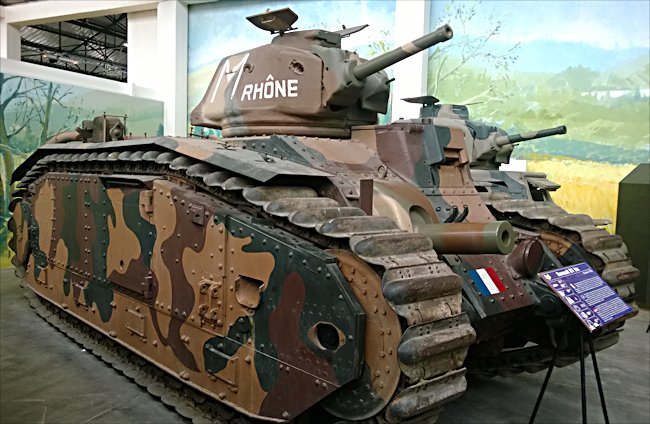
Char B1 bis Renault French Heavy Tank. Notice the two guns.
The word "Char" means tank from "Char de Bataille" which translated means "battle tank". Only three versions were made. The first tank was just called the Char B1. The second version with a bigger main gun was given the suffix "bis". The up-armoured third version was given the suffix "ter". The Renault B1 bis heavy battle tank was the most powerful combat vehicle used on either side during the 1940 invasion of Belgium and France by the Germans. The French built 369 Char B1 bis tanks. It had a 75mm ABS SA 35 howitzer in the hull and a 47mm SA 35 gun in the turret. It weighed 31.5 tonnes and was very slow with a maximum cross country speed of only 21 km/h (13 mph) and on roads 28 km/h (17mph).
It was very thirsty and required a lot of fuel. This was its down fall. Most of the French Char B1 bis tanks were not lost because they were destroyed by German weapons. Most had to be abandoned and crippled by their crews because they had run out of fuel. The French failed to implement a successful refueling system unlike the Germans who used Jerry cans that could be transported in lorries and used to refuel multiple vehicles at the same time. The French used petrol tankers and only one tank could be refueled at a time.
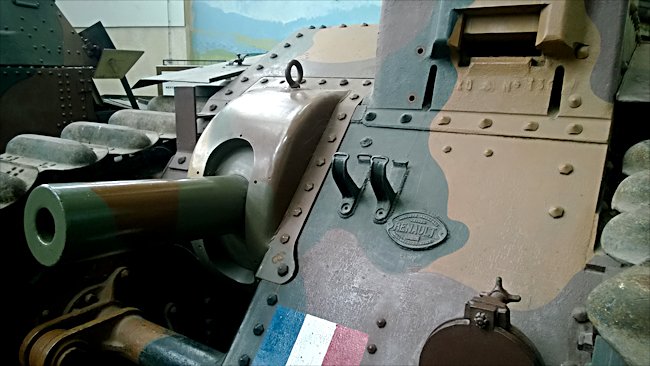
75mm Howitzer on the Char B1 bis Renault French Heavy Tank
Char B1-bis French heavy tanks attack Stonne 1940
By the 13th may 1940 the Germans planed invasion of France had crossed the Meuse river near Sedan. They had taken the French and British by surprise by storming through the difficult hilly and rough countryside of the Ardennes. The first French counter using FCM 36 light tanks had resulted in the loss of 24 out of 34 tanks.
The Germans headed west through a narrow pass between the hills just north of Chemery. This left his flank extended, poorly defended and open to attack. The French realised this was the opportunity they needed. They sent two battalions of their heaviest tanks the Char B1 straight into the vulnerable German flank.
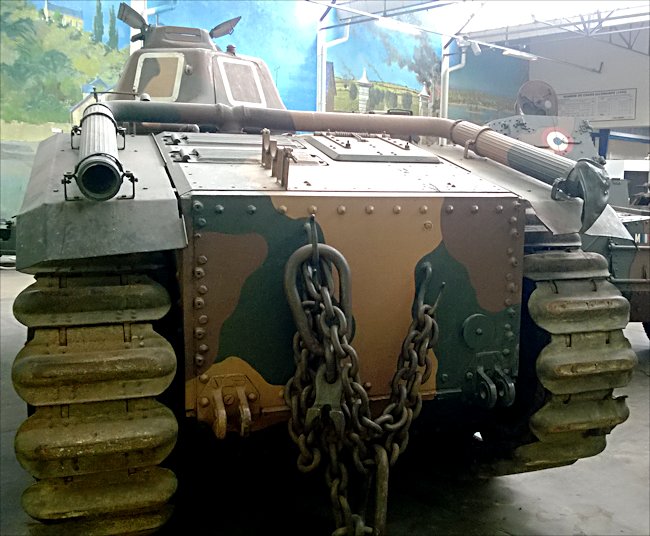
Char B1 bis Renault French Heavy Tank twin exhaust and recovery towing chains.
On 15th May 1940 the French attacked aiming to take the high ground near the village of Stonne. It was crucial for the Germans to keep control of this high advantage point so they could keep control of their bridgehead. The French deployed 68 Char B1 heavy tanks. This was the most feared tank for the German tank crews. With 60mm of armour and a large gun it was their nightmare.
Leon Honor was a member of the crew of a Char B1 in the 49th Tank Battalion 3rd DCR on that day, "The day of the battle was very nice. It was ideal for us. We had great visibility. We could see far into the fields. We had to go into Stonne on a scouting mission, but we did not have a radio fitted to our B1 tanks at that time, so we were on our own. Not only did we have to fight the Germans but we had also to prevent them getting past us. Going up the hill into the village we did not see anything. No sign or contact with the enemy."
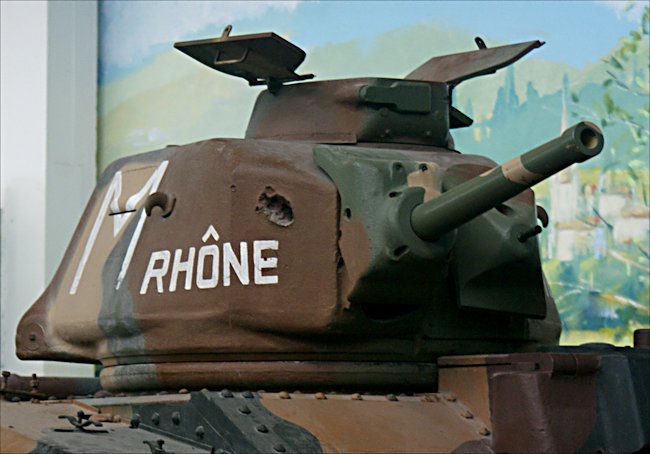
Turret on a Char B1 bis Renault French Heavy Tank. Notice the shell damage to the left of the gun. It did not penetrate the armour due to the cast rounded turret.
"We first made contact when German machine guns on the water tower opened fire. We had to fire our 75mm main gun at the water tower. So I drove up to get closer. I had to get into position to fire on the machine gun nest. We just had to eliminate them and then move on. One shot did the job. I carried on driving forward firing the 75mm cannon as we went. Inside the Char B we were very confident that the armour would keep us safe from danger or injury."
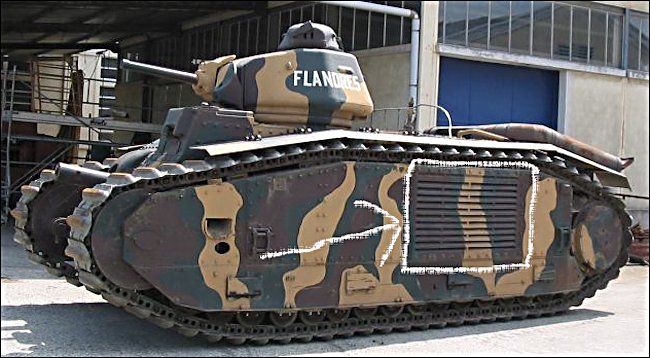
This is the weak spot on the Char B1 bis Renault French Heavy Tank
Hiding in some bushes was a platoon of German anti-tank guns. Their shells just bounced off the strong 60mm frontal armour of the French Char B1-bis tanks. Then one of the French tank commanders did a silly thing. He moved his tank to the right presenting the side of his tank to the Germans. One of the keen eyed Gunners noticed that there was a square grill at the back of the left side of the Char B1.
He aimed his gun and fired to that location. The shell went through the armoured metal grill and the tank caught fire. Word spread that the French heavy tanks had a weak spot so all the guns aimed for that same location. The French tank crews decided it was time to retreat and laid down a smoke screen.
On 16th May 1940 a single Char B1 attacking a German panzer column near Stonne knocked out thirteen panzers and two German 37mm anti-tank guns. Later examination of its armour revealed that it had been hit 140 times without a single shell penetrating the thick armour.
General Charles de Gaulle Commanded Char BI-bis tanks
It was not until just before the German invasion commenced that General Charles de Gaulle, was appointed to command and organise the new French 4th armoured division. Frustratingly, on 15 May 1940, he was only able to gather three tank battalions. This was less than a third of the correct armoured strength. He had less than half his officers.
He was expected to launch a counter-attack with his forces against the German blitzkrieg. In the process he lost a quarter of his tanks to mines, anti-tank weapons and Luftwaffe Stuka dive bombers.
The heavy French char B1-bis tanks, under the command of Major Bescond, gave the 1st Panzer Division a very nasty surprise. The intervention of the 10th Panzer Division and the death of Major Bescond forced them to retreat.
In a desperate attempt to slice through the German blitzkrieg spearhead, French general Charles de Gaulle, with only three tank battalions, in the under strength 4e Division cuirassée (4e DCr), launched an unsuccessful counter-attack at Montcornet.
He only had 85 battle tanks. The town was of strategic importance. Capturing it would cut the 1st Panzer Division's line of supply and the roads to Reims, laon and Saitn-Quentin
This counter-attack started on 17 May 1940 at 4.14am. The Germans only had 37 mm anti-tank guns. Their shells just bounced off the thick armour of the French Char B1-bis tanks. Some of the French tanks had to be abandoned because of lack of fuel. A few others were abandoned when they sank in a swamp which they could not get out. Others were destroyed by German Luftwaffe bombing.
Some of the French battalions D2 tanks came under fire from 88mm anti-tank guns and blew up. The French lost 23 tanks, disabled, destroyed or abandoned in this action stop. Fourteen soldiers were killed, nine were recorded as missing and six wounded. The Germans lost 100 soldiers in the attack. The French retreated at 6pm due to lack of support and repeated attacks by the Luftwaffe.
The defeat of France by the Germans was swift and humiliating. The French army was very strong pull the led. It's heavy tanks were far superior to the German panzers. The French commanders failed to use this advantage to stop the German blitzkrieg.
The tanks were not massed together to form a powerful armoured weapon that would be capable of smashing the German assault. Instead, they were deployed in ineffective small groups. Logistics calls the French army major problems. They lost many tanks not from any enemy action, but from mechanical breakdown, lack of fuel or no resupply of ammunition.
WW2 tank books

